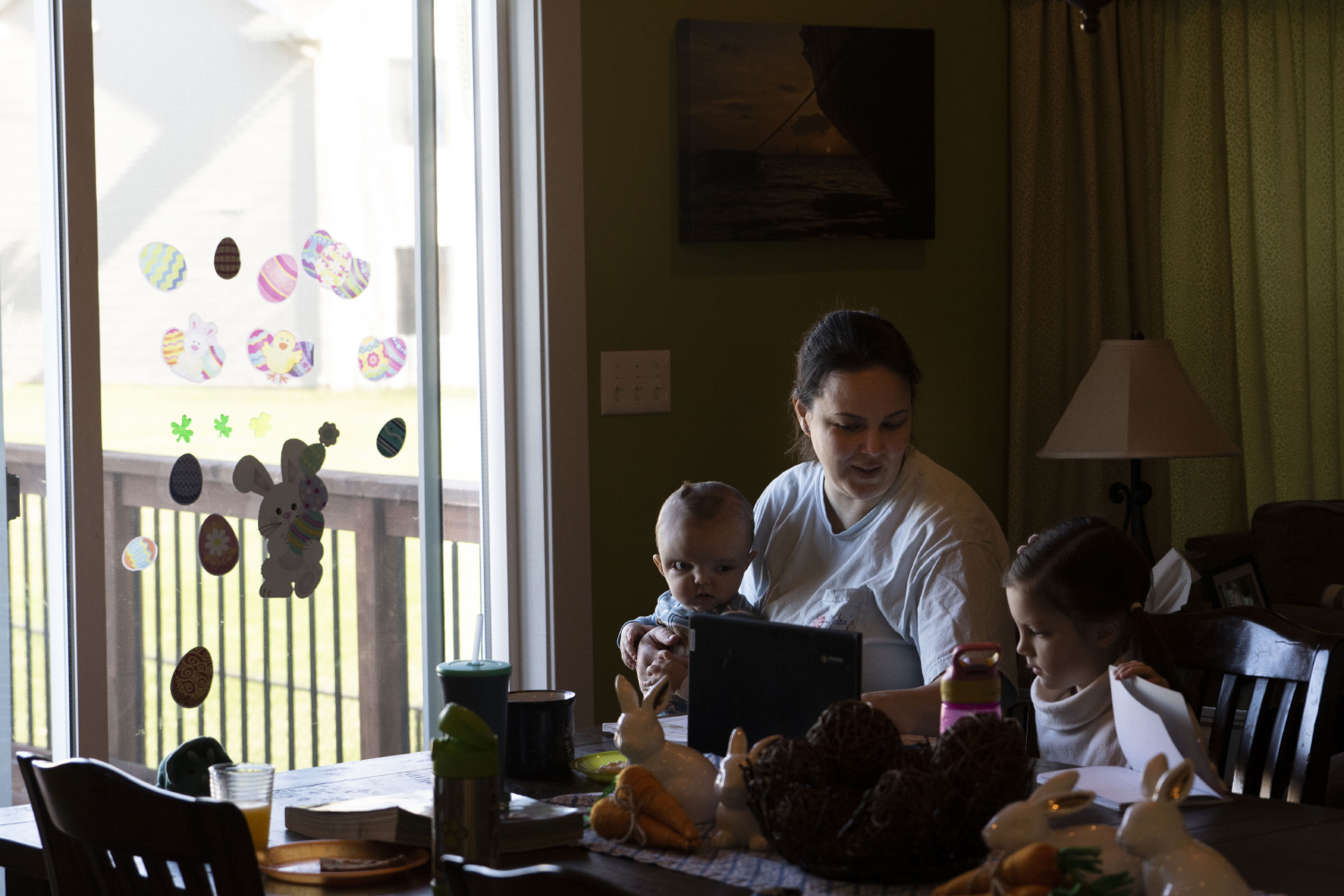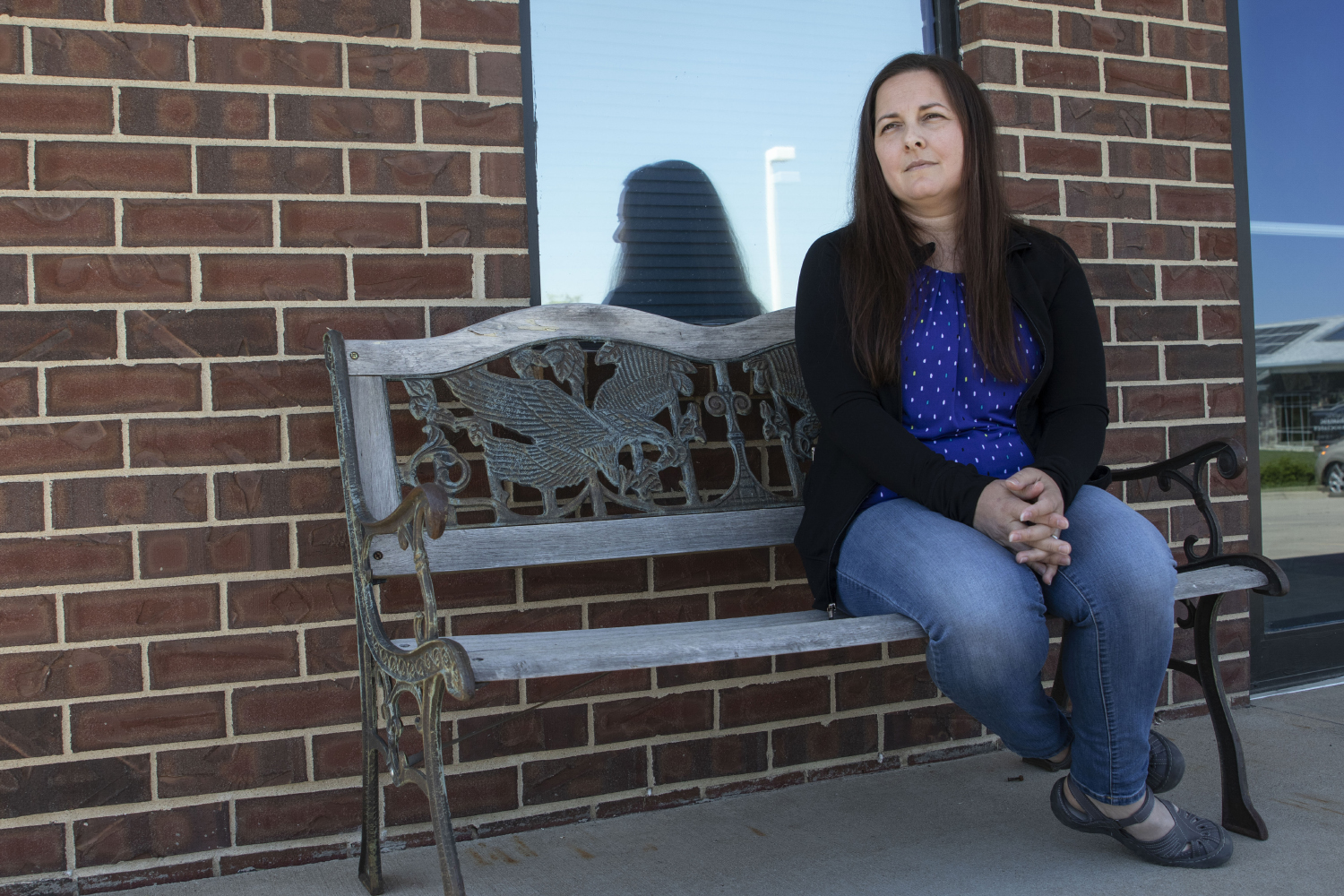Supporting and being supported: Mothers navigate life over a year of COVID-19
In the U.S., where women are relied on in both the personal and professional worlds, the COVID-19 pandemic has pushed mothers to do what they can to get by.
May 10, 2021
Brooke Buxton sat on the ground in her front yard, attempting to wrangle five kids into the shade underneath a tree. Beside her was a wagon, filled with plastic totes, soil, and small plants. The lesson of the day was on terrariums.
The mother of three recalled teaching the same lesson to her first-grade classes at Shimek Elementary in past years. Now, Buxton’s classroom has moved to her house and her class has shrunk to her own children and a few of their friends.
Buxton, like many mothers during the COVID-19 pandemic, decided to leave her job to stay home with her children and help them learn online.
“It was scary, very scary, for me to make the decision for me to stay home. I remember calling my principal like bawling to him saying I can’t believe I’m doing this, but I did it…” Buxton said. “I would do it again if I had to.”
No matter their situation, mothers have seen their workloads — professional, parental, and mental — increase exponentially during the COVID-19 pandemic, being forced to make hard choices and do what they can to survive.

Laura Greenwood sits at her kitchen table with her daughter Bridget, seven, and son Reid, one, on Thursday, April 1, 2021. “The beginning of the pandemic was scary, very scary.” Greenwood said. “We were expecting a baby and there was a lot of uncertainty.”
Finding support where they can
Aislinn Conrad loved her life before the COVID-19 pandemic. She had a thriving social life, work as an assistant professor in the University of Iowa School of Social Work she loved going to, and full-time daycare for her 4-year-old and 7-year-old sons, who she splits custody 50/50 with her co-parent. After her “last good weekend” before the UI’s 2020 spring break, she said she lost her whole support system.
The daycare closed. School sent the kids home. Friends were worried about mingling with other families. And Conrad found herself caring for her sons while trying to work remotely full-time.
“I was in such grief and shock, and then also was caring for my kids 50 percent up and above my normal job, that I really lost the ability to function,” Conrad said. “I couldn’t work because I was just in shock, and just grief-ridden and the most depressed that I’ve ever been.”
Starting in March 2020, Conrad said she felt like she was just struggling to keep her head above water while working 80-100 hours a week between both her kids and job. She entered therapy, which she said has recently started to help her cope with her anxiety and depression. In June, Conrad and her co-parent hired a nanny to go between their homes, coming over three days a week.
By November, she found she was unable to keep going in isolation and started to loosen her own COVID-19 restrictions. Her support network — friends who helped with the kids, friends who came over just to be another adult in the house, single moms she knew — had disappeared, and she needed them back.
“I was interacting with my then-partner … my co-parent, and the nanny. And that was basically it,” she said of the three people who entered her home during this time.
In addition to bringing people back into her life, a year after the pandemic began she sent her oldest son back to school at Lucas Elementary and her younger son to daycare. This let her focus on her work and have time for herself rather than having to entertain and mediate until they went to bed, like she had been doing for the past 12 months.
Conrad’s support system has recently become stronger than ever, and she’s able to have fun with her children without the exhausting task of juggling 24/7 monitoring while working a full-time job.
“I really think it took losing everything in order for what’s really important to come into focus and to guide my existence rather than maybe what used to guide my existence, including my children, who are the most spectacular humans,” she said.
Buxton made the decision to keep herself home with her 4-year-old, first-grader, and third-grader for multiple reasons. As a teacher, she was unsure of how safe she would be in school. As a parent, it made more sense for her to stay home and use her profession to keep her kids learning, and she wasn’t sure who would be able to watch the kids while she worked. As an individual, navigating being a full-time worker and a full-time mom was daunting.
Grandparents live nearby and take her 4-year-old off Buxton’s hands once a week, but she said she knew that if she had decided to stay on at work, they wouldn’t have felt comfortable taking care of them while she worked because of concerns surrounding COVID-19.
The teachers Buxton knows who have continued to work during the pandemic have been getting support from their families to allow them to go into school or work without interruptions at home, she said.
Buxton found camaraderie in another family, whose kids come over to participate in online school and hang out with her children. She said it’s nice to give the kids some social interaction while still staying safe, and Buxton and her husband can see their parents.
“We feel so lucky that I was able to work out that I could take a year off from my job, because, like, a lot of my friends I know, weren’t able to have that convenience of doing that, or that ability to do that,” she said.
Laura Greenwood has been a stay-at-home mom since she had her first daughter in 2013. She now has three children, with her youngest son born in April 2020 with a medical condition, leaving him without an eyelid.
This has made Greenwood’s family extra cautious, which means she has three kids usually cooped up in the house or backyard and her husband upstairs in his office. While neither Greenwood or her husband’s jobs have changed because of the pandemic, she’s had to become an educator as well as a mother to her children.
With two young children and a baby, Greenwood doesn’t get much time to herself. With the pandemic making her youngest even more at risk of catching an infection, she doesn’t see other adults, either.
“Feeling like the only safe place for us to be was in these four walls was really different than I’m used to in terms of parenting,” Greenwood said.
Her support system shrunk to her parents after she had the baby, as they had already planned to come down for a while when he was born. Her mother ended up staying six weeks, helping out with the other kids and doing whatever she needed while they had to isolate.
Most of Greenwood’s friends haven’t even met her youngest, and she hasn’t had a reliable helper since her parents came to stay.
“I hope to … feel like our family and friends can become reliable helpers to us again,” she said.
Nicole Johnson and her son Elon explore Terry Trueblood recreational area on Monday, March 29, 2021. Johnson moved to Iowa City with her family in June.
Navigating and negotiating in an unsupportive system
When Nicole Johnson had her now-4-year-old son, she thought she would have the time and energy to do everything an “ideal mom” in her eyes would: work full-time, make organic food, and breastfeed for two years, among other things.
However, she didn’t see herself falling into the “default parent” role until it started happening. She recalled negotiating with her husband about what exactly their roles would be and how household and parental duties would be split, but she still felt as though it was expected for her to fall into more of a housewife role.
“I think that … gender socialization does place women in a role where they are primary caretakers, and that’s not a role that is ideal for me,” Johnson said.
According to Unicef, gender socialization is defined as the “process by which individuals develop, refine and learn to ‘do’ gender through internalizing gender norms and roles as they interact with key agents of socialization, such as their family, social networks and other social institutions.”
Johnson found herself having to renegotiate with her husband their duties when the COVID-19 pandemic began and she began to do her work for the Iowa City Veterans Affairs Health Care System from home. She said she could see herself falling back into the default parent role, even when both her and her husband — whose job allowed him to work from home before the pandemic — worked full-time from the house.
“There were a lot of times in the beginning where I found myself as the default parent and having to have those conversations again, to sort of recalibrate who’s doing what, when, and whose job gets prioritized when, and, you know, who has the next deadline or whatever, whatever we’re managing at the time,” Johnson said. “And it’s a constant negotiation, sometimes day by day, most of the time, ideally, it’s week by week.”
According to a Pew Research Center study from October 2020, 39 percent of working mothers said balancing work and family responsibility has become harder during the COVID-19 pandemic compared to 28 percent of men. Fifty-four percent of working moms said at one point during the pandemic they’ve felt like they can’t give 100 percent at work, and 43 percent of working dads said the same.
“I think that one of the things that the pandemic has made, has exacerbated and kind of made visible on some level, is that the U.S., regardless of whether motherhood is something that is promoted, or pathologized, it’s completely unsupported,” Natalie Fixmer-Oraiz, an associate professor of communications studies and gender, women, and sexuality studies at the UI, said.
Fixmer-Oraiz researches reproductive politics and contemporary reproductive politics in the U.S.
The U.S. has a lack of “robust child care infrastructure,” Fixmer-Oraiz said, such as adequate family leave, affordable and available child care facilities, and sufficient funding for public education programs, which families have been dealing with long before the pandemic began.
During the pandemic, the country has fallen back on women to make up for this, Fixmer-Oraiz said.
“This is what I’ve always known about what it means to be a mom, is that basically you’re on your own, and you must rely on a patchwork system of childcare when it’s available,” Conrad said. “And it’s very expensive, so you have to rely on your family and friends. And then ultimately, you must rely on yourself.”
Buxton said she didn’t think society’s gender expectations have affected her as a mother or a professional, as she and her husband have always presented themselves as a team. The difficult decision to have her be the stay-at-home parent during the pandemic came down to her teaching background, rather than anything else.
Likewise, Greenwood said her and her husband’s upbringings with stay-at-home moms led to their decision to have Greenwood stay home while the children are growing up. They chose a more traditional route, she said, rather than having it pushed on them.
“I know, if I had a job outside of our home, we would need to be dividing differently,” Greenwood said. “But by choice, we set up our marriage to work this way so that I could be home with our children for this period.”
Kara Houser, a lecturer in the UI School of Social Work and clinical social worker/family therapist at a private practice, said before the pandemic, her household was broken down pretty traditionally. Her husband had a longer commute and less flexibility in his job than her, so she took on the bulk of childcare of her four children, all between the ages of 11 and 16.
Due to the confidentiality of her work and the access to privacy and internet her offices give her, Houser wasn’t able to stay home to work during the pandemic, while her husband’s work allowed him to work from home while the kids did online schooling. This resulted in an almost switching of roles; Houser out of the house and her husband taking on the primary role in their kids’ lives during the day.
“So many things happened behind the scenes, I think, you know, in some way we took for granted, the things that were sort of seamlessly working for us for many, many years until that system was challenged,” Houser said.
Conrad had her own expectations of motherhood, which she described as “naive.” When she pictured being a mom, she saw herself with a baby peacefully sleeping in a wrap against her chest while she worked on her dissertation.
No one told her about how exhausted she would be, taking care of a crying baby who doesn’t want to sleep at night. No one warned her about postpartum depression and anxiety, the first she experienced with her older child and the second she experienced with her younger child.
Before the pandemic, motherhood was quiet. Women were expected to be at work and fully engaged, despite any responsibilities they may have outside of the workplace, Conrad said. Children were almost seen as a distraction, in an unspoken way.
COVID-19 has caused professional and personal worlds to crash together, she said, forcing employers to acknowledge what parents have going on behind the scene. They have to accept that she’ll have to step away from meetings sometimes to help her children, and that she can’t just exist for work.
“One of the most beautiful things about COVID-19 pandemic time is that those walls had to come down, because nobody had a choice,” she said. “And so now, it just seems like it’s more frank and centered in the work experience that you might hear kids screaming in the background, and people will giggle.”

Kara Houser sits outside of her therapy office on May 5, 2021.
Moving forward
As more people get access to the COVID-19 vaccine and society begins to open up, many moms are getting ready to send their kids back to activities and school, and head back into the world themselves.
Conrad said for the past two months, since her children have been back in school, she’s begun to get little pieces of her life back. Biking to the gym, seeing friends, and getting to do other activities have brought back her passion.
Greenwood is looking forward to the little things, like going back to the library and taking her 1-year-old to the store. She said it’s crazy to think that her kids don’t remember experiencing certain activities, even ones as commonplace as going to Target.
Johnson is gearing up to head back to work in-person. She said her son will start full-time preschool in the fall, as she’s feeling more comfortable with the safety of in-person classes and doesn’t want to put the full load of caring for him on her husband.
“I’ve been forced to create a new normal for my family, and we’re doing okay now,” Johnson said. “And I’m going to be forced to create another new normal that won’t be the same as the old normal. And I know that will be OK.”
Tearing up, Buxton said she’s so privileged to have had the choice to stay home without negative consequences for her family. There are so many mothers who can’t take care of their kids 24/7, because of work or for other reasons, and she’s tried to appreciate every little moment.
Buxton’s plan is to return to teaching in the fall, though she won’t know if she’ll get to teach in Shimek Elementary again. As with many families during the pandemic, Buxton and her family will be reentering the world a little different from when they first isolated from it. She’s going to try and keep work at work rather than bring stress home with her, and have her family at home more in between their crazy lives.
“It’s going to be a rude awakening for us, but I think we can do it,” Buxton said.
Through her work as a family therapist, Houser talks to many mothers, and said one theme she’s been hearing throughout the pandemic is that they’re just doing what they can to get by. Whether this means ordering takeout more, caring less about certain aspects of life from before the pandemic, or letting kids rely on technology more than ever before, mothers are just trying to help their families survive.
“They’re, they’re not sure if they’re making the right decision. And there’s a lot of second guessing that’s coming along with that,” Houser said.
Houser has had to make concessions with things such as technology to keep her kids learning and connected, but she’s worried about how reliant they’ll be on technology when they’re fully able to enter the world once again. As they move forward, Houser will continue to try and balance how she feels about the changes in her family versus taking their wants and needs into account. She’ll keep getting by.
“The pandemic has been something that, as a mother, you really continue to want to put your children’s needs first. And of course, I think parents are doing that,” she said. “But at the same time, you’re also coping with that, and how you can balance that is really tricky.”

